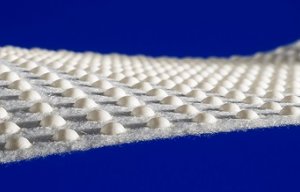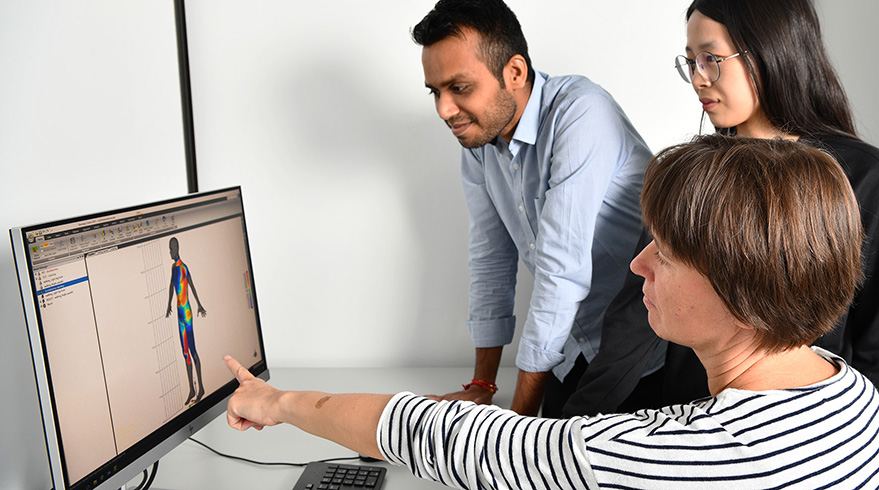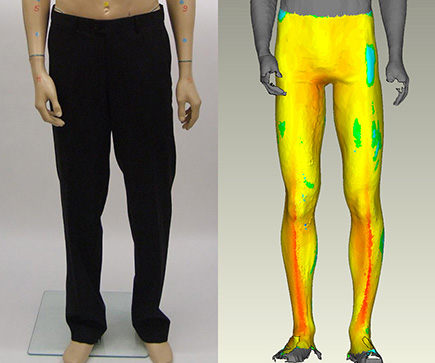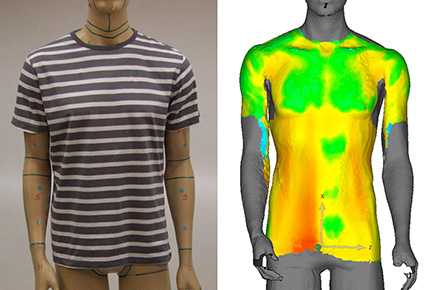
Monforts to present new Montex XXL stenter at INDEX17
Empa scientists have developed a model that predicts how well a given garment will keep us warm.

21st November 2019
Innovation in Textiles
|
Switzerland

A colour code indicates where garment best isolates the human body. © Empa
Whether for sports, at work or in the living room – depending on activity and environment, our clothing has to meet different demands. Empa scientists have developed a model that predicts how well a given garment will keep us warm. The crucial factor is the air cushion between our body and the outermost layer of clothing.
In winter, it can look sunny and warm. But as soon as we are exposed to the elements, we start freezing. If our clothing is not adapted to the conditions, we quickly feel uncomfortable. Garment developers, on the other hand, want to adapt their products as closely as possible to the requirements of their customers. To see whether T-shirts, jackets or shoes deliver what they promise, tests with prototypes have been necessary for the longest time.
 Empa scientists have now developed a computer program that calculates how warm and cosy a person feels when wearing a piece of clothing. The thermal comfort of, say, a winter jacket is not primarily determined by its fabric. “Much more important are the layers of air between the body and the fabric,” explained Empa researcher Agnes Psikuta. “Air cushions are responsible for more than 70% of a garment's properties.” This is because air is an excellent insulator. Thus, clothing insulates particularly well when there is a lot of air between the body and the outermost layer of clothing. If this air escapes, the insulation suffers and one begins to freeze.
Empa scientists have now developed a computer program that calculates how warm and cosy a person feels when wearing a piece of clothing. The thermal comfort of, say, a winter jacket is not primarily determined by its fabric. “Much more important are the layers of air between the body and the fabric,” explained Empa researcher Agnes Psikuta. “Air cushions are responsible for more than 70% of a garment's properties.” This is because air is an excellent insulator. Thus, clothing insulates particularly well when there is a lot of air between the body and the outermost layer of clothing. If this air escapes, the insulation suffers and one begins to freeze.
To date, most scientific models for predicting heat loss have been based solely on the types of fabric that have been used to manufacture a piece of clothing. Fabrics, however, fall very differently when a body moves. This also changes the insulating air layers; but only a permanent layer can insulate well. Researchers have, therefore, looked for solutions to calculate the change in air cushion thickness during movement. “We used computer programs developed for the fashion industry as a basis. These programs simulate the situation on a catwalk. Designers can send out a virtual model and see how their newly designed clothes look on a person in motion.” It turned out that these computer programs can accurately predict how clothes will behave on the body.
The software developed by Ms Psikuta and her team combines different calculation models that interact with each other. In addition to air layers, the program predicts comfort as well as the influence of sweating or certain movements on the garment. Finally, a cutting pattern is transformed into a virtual piece of clothing that can be worn by an avatar.
 But the program can also help, for instance, to develop an optimal outfit for running in autumn. “Even before the fabrics or the design have been determined, our software calculates how clothing should be cut,” explained Ms Psikuta. And all this not only for standard sizes. “Our program can shape the avatars according to different body types and sizes. If, for example, something is to be developed for particularly muscular, curvy or slender people, we can adapt the program accordingly and see how it would look.”
But the program can also help, for instance, to develop an optimal outfit for running in autumn. “Even before the fabrics or the design have been determined, our software calculates how clothing should be cut,” explained Ms Psikuta. And all this not only for standard sizes. “Our program can shape the avatars according to different body types and sizes. If, for example, something is to be developed for particularly muscular, curvy or slender people, we can adapt the program accordingly and see how it would look.”
In the end, the program helps to replace countless prototypes for the development of new clothing and functional gear. As this also eliminates the need for time-consuming test runs, the development period is reduced by up to 90%. “How much time we can actually save depends greatly on the product in question and its complexity,” said Ms Psikuta. “For instance, protective clothing for firefighters – ultimately a life-saving piece of equipment – has a very complex structure, while a sports T-shirt, on the other hand, is quite a bit easier.”
However, operating the computer program is anything but trivial. In order to test the research results in practice, Empa cooperates with industrial partners who, for example, manufacture functional gear for winter sports. “They come up with new ideas, and we support them with our technology and help them to develop their clothes in the shortest possible time,” said Ms Psikuta.

Business intelligence for the fibre, textiles and apparel industries: technologies, innovations, markets, investments, trade policy, sourcing, strategy...
Find out more